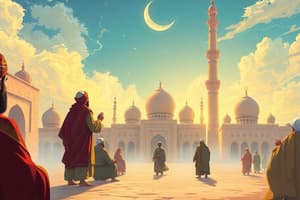Podcast
Questions and Answers
Before the rise of Islam, what role did the Arabian Peninsula play as Southwest Asia?
Before the rise of Islam, what role did the Arabian Peninsula play as Southwest Asia?
- A bridge for trade and the exchange of ideas between Africa, Asia, and Europe (correct)
- A region isolated from outside influence due to its desert climate
- A cultural center of philosophical movements
- A major agricultural center exporting goods to other regions
What geographical features primarily dictated the lifestyle of early inhabitants of the Arabian Peninsula?
What geographical features primarily dictated the lifestyle of early inhabitants of the Arabian Peninsula?
- Vast deserts and limited fertile land, leading to nomadic lifestyles (correct)
- Extensive river systems that supported large-scale irrigation
- Dense forests providing timber and varied resources
- Mountainous terrain fostering isolated, agrarian communities
How did the Bedouin tribes adapt to survive in the harsh desert environment of the Arabian Peninsula?
How did the Bedouin tribes adapt to survive in the harsh desert environment of the Arabian Peninsula?
- By forming organized tribes and clans providing security and support (correct)
- By constructing permanent settlements along major trade routes
- By developing advanced irrigation techniques for desert farming
- By relying on maritime trade due to proximity to major seas
What factor facilitated the growth of larger towns along the western coast of Arabia in the early AD 600s?
What factor facilitated the growth of larger towns along the western coast of Arabia in the early AD 600s?
What were the primary trade partners connected to Arabia through trade routes by the early AD 600s?
What were the primary trade partners connected to Arabia through trade routes by the early AD 600s?
How did the ideals of courage and loyalty, traditionally valued by the Bedouins, influence Islamic culture?
How did the ideals of courage and loyalty, traditionally valued by the Bedouins, influence Islamic culture?
How did Islam politically unify the Arab people?
How did Islam politically unify the Arab people?
What best illustrates the geographical importance of the Arabian Peninsula?
What best illustrates the geographical importance of the Arabian Peninsula?
What was the main reason for nomadic Arab herders to inhabit the desert regions of the Arabian Peninsula?
What was the main reason for nomadic Arab herders to inhabit the desert regions of the Arabian Peninsula?
How did new shared ideas contribute to the rise of Islam?
How did new shared ideas contribute to the rise of Islam?
How did Muhammad's leadership contribute to the unification of the Arab people?
How did Muhammad's leadership contribute to the unification of the Arab people?
What made the Islamic religion a pivotal force in world history?
What made the Islamic religion a pivotal force in world history?
What characterized the nature of trade routes that connected Arabia with other regions?
What characterized the nature of trade routes that connected Arabia with other regions?
Before the settlements, what limited the agriculture production in the south of Arabia and Oman?
Before the settlements, what limited the agriculture production in the south of Arabia and Oman?
What role did clans play in the Bedouin's tribal society?
What role did clans play in the Bedouin's tribal society?
Which geographical area did the trade routes not run through?
Which geographical area did the trade routes not run through?
Aside from warrior skill and loyalty to the family, what else did the lifestyle of the Bedouins provide?
Aside from warrior skill and loyalty to the family, what else did the lifestyle of the Bedouins provide?
What did the larger towns near the western coast of Arabia become?
What did the larger towns near the western coast of Arabia become?
What continents is the Arabian Peninsula crossroads of?
What continents is the Arabian Peninsula crossroads of?
How long is the Arabian Peninsula from north to south?
How long is the Arabian Peninsula from north to south?
Flashcards
Arabian Peninsula
Arabian Peninsula
The Arabian Peninsula is a crossroads connecting Africa, Asia, and Europe.
Bedouins
Bedouins
Nomadic Arab herders that inhabited the deserts of the Arabian Peninsula.
Clans
Clans
Groups that Bedouins organized themselves into, providing security and support.
Tribes
Tribes
Signup and view all the flashcards
Middle East's Role
Middle East's Role
Signup and view all the flashcards
Market Towns
Market Towns
Signup and view all the flashcards
Arabian Trade Routes
Arabian Trade Routes
Signup and view all the flashcards
Bedouin Virtues in Islam
Bedouin Virtues in Islam
Signup and view all the flashcards
Muhammad's Impact
Muhammad's Impact
Signup and view all the flashcards
Study Notes
- Muhammad united the Arab people politically and through Islam
- Islam is the world's fastest-growing major religion and impacts millions of lives
- Key terms and people include: Allah, Muhammad, Islam, Muslim, Hijrah, mosque, hajj, Qur'an, Sunna, and shari'a
The Rise of Islam
- Southwest Asia, referred to as the Middle East, is a bridge between Africa, Asia, and Europe
- Cultures of the Arabian Peninsula were in constant contact for centuries
- Goods and ideas were traded
- Shared ideas became a powerful force for change in the world- the religion of Islam
Deserts, Towns, and Trade Routes
- The Arabian Peninsula is a crossroads of Africa, Europe, and Asia
- The peninsula is about 1,200 miles from north to south and 1,300 miles from east to west
- Only a tiny strip of fertile land in south Arabia and Oman and a few oases support agriculture
- The rest is desert, inhabited by nomadic Arab herders
- Arab nomads, called Bedouins, were organized into tribes and clans
- Clans provided security and support
- Bedouin ideals of courage, loyalty to family, and warrior skills would become part of Islamic life
- Areas with fertile soil and larger oases had enough water to support farming communities
- By the early AD 600s, many Arabs settled in an oasis or market town
- Larger towns near the western coast of Arabia became market towns
- By the early AD 600s, trade routes connected Arabia to major ocean and land trade routes
- Trade routes through Arabia ran from the southern peninsula to the Byzantine and Sassanid (Persian).
- Larger towns located to the west of Arabia, became market towns
Additional Facts
-
Arab nomads are Bedouins, organized in tribes
-
Tribes are clans
-
Islamic life of the Bedouins involves:
- Warrior skill
- Loyalty to the family
- Providing security and support
-
Trade routes go through:
- The Arabian south peninsula
- Byzantine and Sassanid
Studying That Suits You
Use AI to generate personalized quizzes and flashcards to suit your learning preferences.




